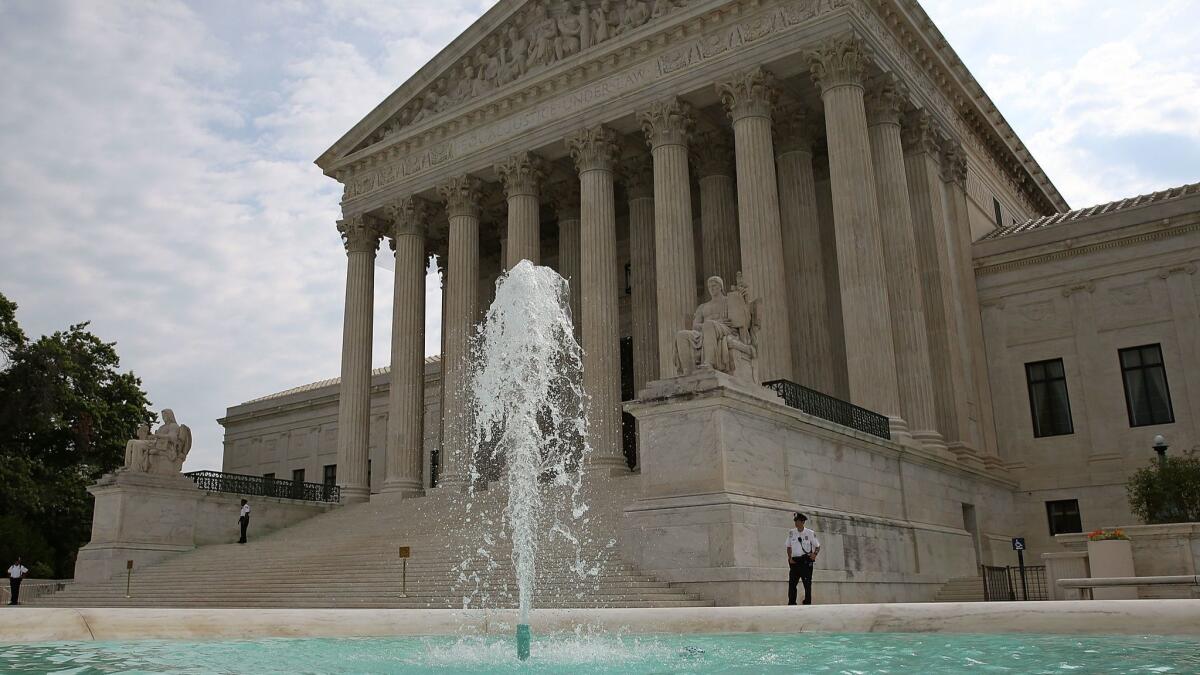Supreme Court limits habitats protected under the Endangered Species Act

- Share via
Reporting from Washington — The Supreme Court on Tuesday limited the reach of the Endangered Species Act, setting aside a lower court ruling that afforded protection to an area where threatened animals do not live but might one day with significant changes.
The justices, in a unanimous but narrowly written decision, questioned whether a wooded area in Louisiana could be deemed under the law as a “critical habitat” for endangered frogs who might be able to live there in the future if some trees were removed.
The roughly 100 remaining dusky gopher frogs live only in a single pond in a wooded area nearby in Mississippi.
The justices did not decide whether the Louisiana area could be a protected habitat. Instead, they sent the case back to the 5th Circuit Court in New Orleans to reconsider the matter and make a final decision.
However, Chief Justice John G. Roberts Jr. said in his opinion that the “critical habitat” of an endangered species “must also be a habitat.”
The 8-0 ruling is a partial victory for the Weyerhaeuser Co. and other development companies that challenged the broad habitat protections imposed by the U.S. Fish and Wildlife Service.
Environmentalists stressed the ruling was quite limited and left open the possibility that the Louisiana habitat for the frog could win protection.
“While we’re disappointed, the ruling doesn’t weaken the mandate to protect habitat for endangered wildlife,” said Collette Adkins, a lawyer for the Center for Biological Diversity. “We’re hopeful the 5th Circuit will recognize the importance of protecting and restoring habitats for endangered wildlife.”
The case was heard on the first Monday in October, and the eight justices sounded closely split.
Justice Brett M. Kavanaugh took no part in the decision because the case was heard a week before he won confirmation in the Senate.
The four more liberal justices spoke in defense of the Fish and Wildlife Service, while the conservatives questioned how a critical habitat could include an area where the endangered frog did not live and could not live unless changes were made.
In the end, the chief justice found a way to bring both sides together by deciding very little.
In one section, the Endangered Species Act calls for protecting habitat that is “essential to the conservation of the species.”
The 5th Circuit in a 2-1 decision agreed with the Fish and Wildlife Service that the designated forestland in Louisiana was “essential to the conservation” of the tiny endangered frogs. They breed in small ponds that dry up for part of the year, and they need sunlight from open-canopy forests. The wooded tract in Louisiana was said to be well suited for the frogs and would require only minor changes to preserve them. The agency designated a 1,544-acre tract as critical habitat for the frogs. This designation did not require immediate changes in the land, but it would have limited future development by Weyerhaeuser and other owners of the land.
They appealed in Weyerhaeuser vs. U.S. Fish and Wildlife and argued the phrase “critical habitat” could not be interpreted to include any area where an endangered species might live only if significant changes were made.
The chief justice agreed the scope of the law was limited. “Only the ‘habitat’ of the endangered species is eligible for designation as critical habitat,” Roberts said. “Even if an area otherwise meets the statutory definition of unoccupied critical habitat because the secretary finds the area essential for the conservation of the species, [the law] does not authorize the secretary to designate the area as critical habitat unless it is also habitat for the species.”
But he also said the law itself does not define the crucial word “habitat,” and he said the 5th Circuit should decide that issue.
Roberts also agreed with Weyerhaeuser that the 5th Circuit should weigh the “economic impact” before approving the designation of the Louisiana tract as a protected habitat.
More stories from David G. Savage »
Twitter: DavidGSavage
UPDATES:
12:40 p.m.: This article was updated with more details from the ruling.
8:50 a.m.: This article was updated with additional details from Roberts’ opinion.
This article was originally published at 7:35 a.m.
More to Read
Get the L.A. Times Politics newsletter
Deeply reported insights into legislation, politics and policy from Sacramento, Washington and beyond. In your inbox twice per week.
You may occasionally receive promotional content from the Los Angeles Times.











